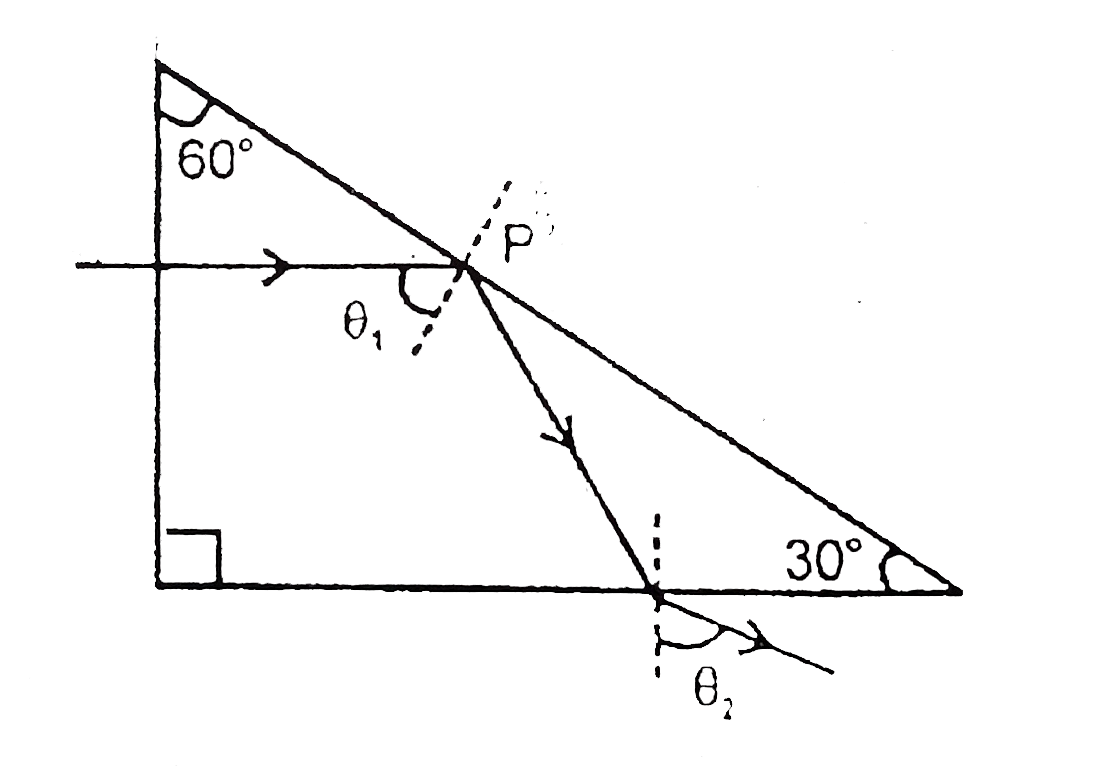A ray of light incident at an angle on a refracting face of a prism emerges from the other face normally. If the angle of the prism is and the prism is made of a material of refractive index , the angle of incidence is.
The correct Answer is:A
To solve the problem, we will follow these steps:
Step 1: Understand the Geometry of the Prism
We have a prism with an angle A=5∘. A ray of light is incident at an angle θ on the refracting face of the prism and emerges normally from the other face.
Step 2: Identify Angles of Refraction
When the light ray enters the prism, it will refract at the first face. We denote the angle of refraction at the first face as R1. Since the ray emerges normally from the second face, the angle of refraction at the second face, R2, is 0∘.
Step 3: Apply the Prism Formula
For a prism, the relationship between the angles is given by:
A=R1+R2
Since R2=0∘, we have:
R1=A=5∘
Step 4: Use Snell's Law
Now we apply Snell's Law at the first interface (air to prism):
μ1sin(θ)=μ2sin(R1)
Where:
- μ1=1 (refractive index of air)
- μ2=1.5 (refractive index of the prism)
- R1=5∘
Substituting the values, we have:
1⋅sin(θ)=1.5⋅sin(5∘)
Step 5: Calculate sin(5∘)
Using a calculator or trigonometric tables:
sin(5∘)≈0.0872
Step 6: Substitute and Solve for sin(θ)
Substituting sin(5∘) into the equation:
sin(θ)=1.5⋅0.0872
Calculating the right side:
sin(θ)=0.1308
Step 7: Find θ
Now, to find θ:
θ=sin−1(0.1308)
Using a calculator:
θ≈7.5∘
Conclusion
The angle of incidence θ is approximately 7.5∘.
---
We have a prism with an angle A=5∘. A ray of light is incident at an angle θ on the refracting face of the prism and emerges normally from the other face.
When the light ray enters the prism, it will refract at the first face. We denote the angle of refraction at the first face as R1. Since the ray emerges normally from the second face, the angle of refraction at the second face, R2, is 0∘.
For a prism, the relationship between the angles is given by:
A=R1+R2
Since R2=0∘, we have:
R1=A=5∘
Now we apply Snell's Law at the first interface (air to prism):
μ1sin(θ)=μ2sin(R1)
Where:
- μ1=1 (refractive index of air)
- μ2=1.5 (refractive index of the prism)
- R1=5∘
1⋅sin(θ)=1.5⋅sin(5∘)
Using a calculator or trigonometric tables:
sin(5∘)≈0.0872
Substituting sin(5∘) into the equation:
sin(θ)=1.5⋅0.0872
Calculating the right side:
sin(θ)=0.1308
Now, to find θ:
θ=sin−1(0.1308)
Using a calculator:
θ≈7.5∘
The angle of incidence θ is approximately 7.5∘.
Topper's Solved these Questions
- RAY OPTICSBook:PRADEEPChapter:RAY OPTICSExercise:(Competition)Multiple choice
Explore 89 Videos
- RAY OPTICSBook:PRADEEPChapter:RAY OPTICSExercise:(Competition)Comprehension
Explore 7 Videos
- RAY OPTICSBook:PRADEEPChapter:RAY OPTICSExercise:(Test Your Grip)Fill in the blanks (d)
Explore 10 Videos
- PROPERTIES OF BULK MATTERBook:PRADEEPChapter:PROPERTIES OF BULK MATTERExercise:Multiple choice questions
Explore 7 Videos
- SYSTEMS OF PARTICLES AND ROTATIONAL MOTIONBook:PRADEEPChapter:SYSTEMS OF PARTICLES AND ROTATIONAL MOTIONExercise:Assertion- Reason Type questions
Explore 20 Videos
Similar Questions
A ray of light incident normally on the first face of a glass prism of refractive index 1.6 just emerges from the other face. Find the angle of the prism.
View SolutionA monochromatic ray of light is incident normally on one of the refracting surfaces of a prism . The emergent ray grazes the second refracting surface . What is the angle of the prism if the refractive index of the material of the prism is 1.6 ?
View Solution
Knowledge Check
A ray of light incident at an angle θ on a refracting face of a prism emerges from the other face normally. If the angle of prism is 5∘ and the prism is made of a material of refractive index 1.5, the angle of incidence is
A7.5∘B5∘C15∘D2.5∘
A ray of light is incident normally on one face of a prism as shown in figure. The refractive index of the material of the prism is 53 and the prism is immersed in water of refractive index 43, thenAThe angle of emergence θ2 of the ray is sin−2(58)BThe angle of emergence θ2 of the ray is sin−1(54√3)CThe angle of emerrgence θ2 of the ray is sin−1(73√4)DTotal internal reflection will not occur at P if the refractive index of water increases to a value greater than 52√3 by dissolving some substance.A ray of light is incident at an angle of 60∘ on one face of a prism of angle 30∘. They ray emerges normally from the other face of the prism. The refractive index of the prism material is
A√2B√3C2D3
When a ray of light is incident normally on one refracting surface of an equilateral prism (Refractive index of the material of the prism =1.5
View SolutionA ray of light is incident at an angle of 60∘ on the face of a prism with an angle of 60∘. Then the refractive index of the material of the prism is (the prism is in minimum deviation position)
View SolutionA ray of light is incident at an angle of incidence 45∘ on an equilateral prism and emerge at an angle 45∘ then the refractive index of the medium of the prism is:
View SolutionA ray of light is incident at an angle of 60∘ on one face of a 30∘ prism . The emergent ray from the prism makes an angle of 30∘ with the incident ray. The angle of emergence and refractive index of the material of the prism are-
View SolutionA ray of light is incident on a refracting face of glass prism of refracting angle 30∘. If the ray emerges normally from the second refracting surface, the angle of incidence is refracting surface, the angle of incidence is
[aμg=1.5]
View Solution